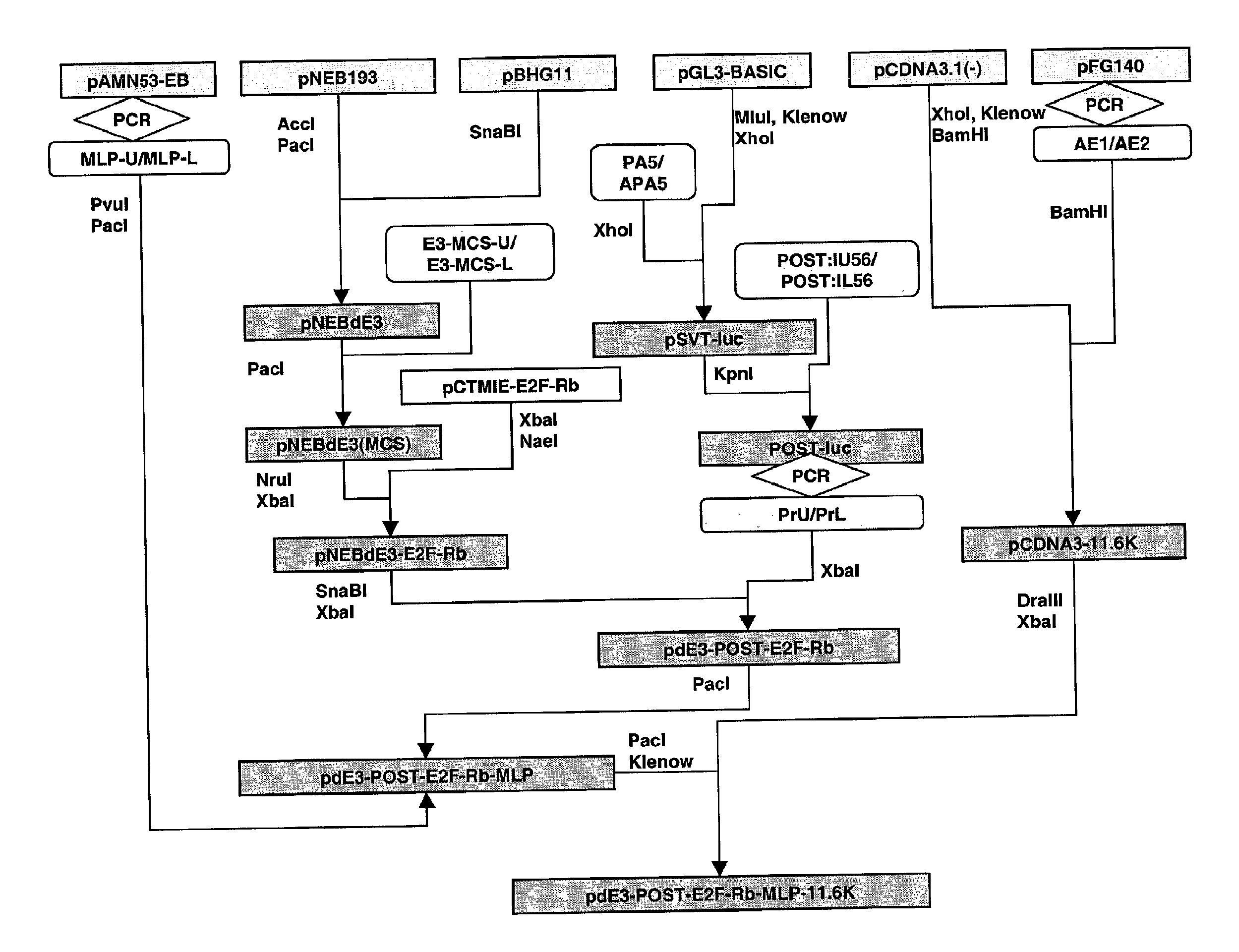Selectively replicating viral vectors
a viral vector and selective technology, applied in the field of selective replication of viral vectors, can solve the problems of “leaky” collapsing damage to non-neoplastic cells, tissue or tumor specific control elements, etc., and achieve the effect of inhibiting viral replication
- Summary
- Abstract
- Description
- Claims
- Application Information
AI Technical Summary
Problems solved by technology
Method used
Image
Examples
example 1
Plasmid Constructions
[0159]p800luc, a plasmid encoding luciferase under the control of 800 by PAI promoter was obtained from Dr. David Luskutoff (Scripps Institute, LaJolla, Calif.). Plasmid pCTMIE-E2F-Rb that contains a CMV promoter followed by adenovirus-5 tripartite leader sequence and a SV40 enhancer upstream of the coding sequence for E2F-RB fusion protein was provided by Doug Antelman (Canji).
example 2
Construction Luciferase Plasmids with TGF-β-Responsive Promoters
A. PAI-Luciferease Plasmid:
[0160]Sequences of all the fragments are shown in 5′-3′ direction A 749 by fragment flanked with SacI and XhoI sites at 5′ and 3′ ends respectively, and SV40 TATA box instead of native TATA box within the promoter, was amplified by PCR using p800luc as the template and primers AGT CGA GCT CCA ACC TCA GCC AGA (SEQ ID NO:1) and GAT CCT CGA GCT CCT CTG TGG GCC ACT GCC TCC TCA TAA ATA CC (SEQ ID NO:2, containing SV40 TATA box). The resulting PCR product was digested with SacI and XhoI and ligated to a fragment obtained after digesting PGL3-basic, a luciferase construct with no promoter (Promega), to obtain PAI-luciferase.
B. SRE-Luciferase Plasmid:
[0161]The following oligonucleotides, GG TAT TTA TGA GGA GGC AGT GGC CCA CAG AGG AGC TCG AGG ATC (SEQ ID NO:3) and GAT CCT CGA GCT CCT CTG TGG GCC ACT GCC TCC TCA TAA ATA CC (SEQ ID NO:4) were annealed. The annealed product was digested with XhoI and liga...
example 3
Construction Luciferase Plasmids with p53-Responsive Promoters
A. RGC-Luciferase Plasmid:
[0162]Two complimentary 5′-phosphorylated oligonucleotides containing p53 binding sites from the ribosomal gene cluster, AG AAA AGG CAA GGC CAG GCA AGT CCA GGC AAC TCG TGG TAC (SEQ ID NO:7) and CA CGA GTT GCC TGG ACT TGC CTG GCC TTG CCT TTT CTG TAC (SEQ ID NO:8) were annealed. The annealed fragment was ligated to pSVT-luciferase digested with KpnI to obtain RGC-luciferase plasmid.
B. p53CON-Luciferase Plasmid:
[0163]Two complimentary 5′-phosphorylated oligonucleotides containing consensus p53 binding sites (p53CON), CT CGA CGG ACA TGC CCG GGC ATG TCC TCG ACG GAC ATG CCC GGG CAT GTC CTG TAC (SEQ ID NO:9) and AG GAC ATG CCC GGG CAT GTC CGT CGA GGA CAT GCC CGG GCA TGT CCG TCG AGG TAC (SEQ ID NO:10) were annealed. The annealed fragment was ligated to pSVT-luciferase digested with KpnI to obtain p53CON-luciferase plasmid.
C. PAI-E2F-Rb Plasmid:
[0164]The sequence containing the CMV promoter followed by ad...
PUM
| Property | Measurement | Unit |
|---|---|---|
| volumes | aaaaa | aaaaa |
| volumes | aaaaa | aaaaa |
| volume | aaaaa | aaaaa |
Abstract
Description
Claims
Application Information
 Login to view more
Login to view more - R&D Engineer
- R&D Manager
- IP Professional
- Industry Leading Data Capabilities
- Powerful AI technology
- Patent DNA Extraction
Browse by: Latest US Patents, China's latest patents, Technical Efficacy Thesaurus, Application Domain, Technology Topic.
© 2024 PatSnap. All rights reserved.Legal|Privacy policy|Modern Slavery Act Transparency Statement|Sitemap



